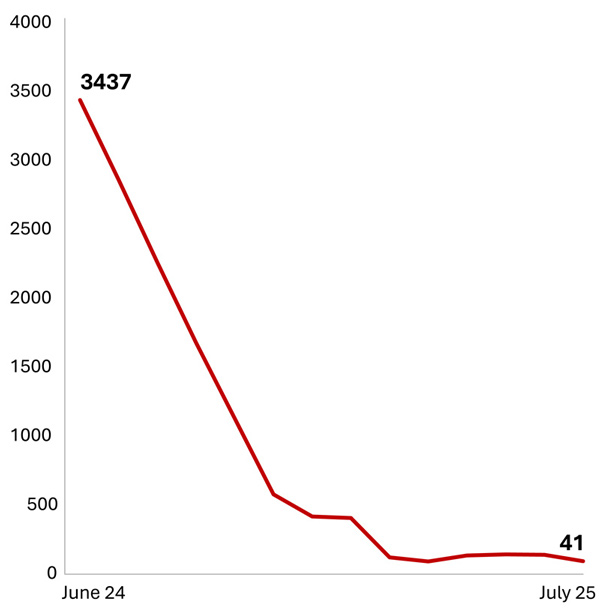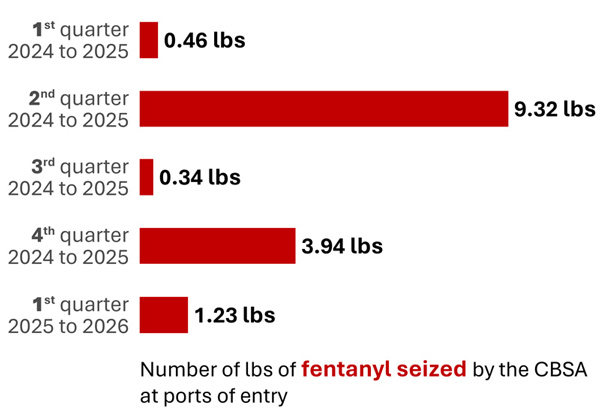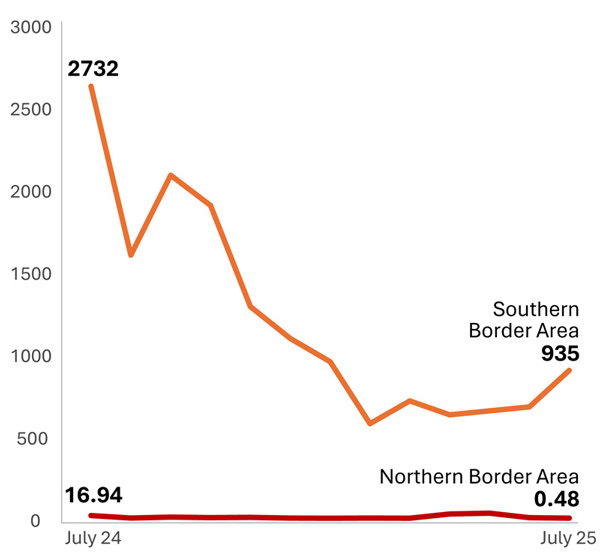Strengthening Canada’s Border Security: Actions Taken to Date
Targeting illicit drugs, cross-border crime and illegal crossings
The Government of Canada has been resolute in its commitment to doing whatever it takes to keep our border secure, because we know that a strong border is essential to our economy, national security, and the safety of our communities. Through the $1.3 billion Border Plan, the Government of Canada has invested in equipment and technology for border and law enforcement agencies to tackle the flow of illegal fentanyl, other illicit drugs, and precursor chemicals; deter organized crime and illegal migration; and increase information sharing and operational coordination with partners.
Securing the border
- 24/7 surveillance of the border
- Approximately 10,000 frontline personnel
- New technology and intelligence capabilities, such as Black Hawk helicopters, drones counter-drone technologies, and mobile surveillance towers
- 1,000 new CBSA personnel, new drones and towers still to come
- New tools in place to address illegal migration
- More visa fraud investigations, more resources identifying high-risk individuals and bringing back some visa requirements on Mexico
- Illegal crossings from Canada to the U.S. down 99% in July 2025 from peak levels in June 2024
- Northbound apprehensions now outnumber southbound
- Using new tools to detect and identify synthetic drugs and precursor chemicals
- Imaging and trace detection, regional satellite laboratories, ion scanners, detector dog teams
- More equipment still to come
- More resources dedicated to removing foreign nationals inadmissible to Canada
- In 2024-25, 18,041 removals were enforced, the most in over a decade
- Expanded CBSA international operations to enhance pre-departure intelligence and targeting, preventing inadmissible individuals and illicit goods from entering Canada
- Border officers increasingly able to focus on higher-risk activity with ending of "flagpoling"
Combatting transnational organized crime and fentanyl
- Canada is not a significant source of illegal fentanyl entering the US. Less than 1% of fentanyl seized in the US comes from Canada
- Between 2022 and June 2025, only 113 pounds of fentanyl were seized at the U.S. Northern Border, while over 70,500 pounds were seized at the U.S. Southwest Border; more than 600 times as much
- Fentanyl Czar
- Leads multi-agency coordination efforts to tackle the production and trafficking of illegal fentanyl
- Inter-agency cooperation
- Prime Ministerial Directive issued on improving intelligence sharing and cooperation between government agencies
- New Joint Operational Intelligence Cell
- Bringing together security agencies and law enforcement partners to target cross-border organized crime, money laundering and drug trafficking to improve border security
- Seven cartels listed as terrorist entities
- Property of those groups can now be frozen and law enforcement has more tools to prosecute offences including those related to financing, travel and recruitment
- North American Joint Strike Force
- Launched with the U.S. to target transnational organized crime, precursor chemicals, and illegal substances, including fentanyl
- Direct engagement and action with China
- Taking place to stop the shipments of illegal precursor chemicals to Canada
- Three new Integrated Drug Enforcement Hubs
- Being created to bring together seconded law and border enforcement resources from multiple agencies and jurisdictions to combat organized drug crime in areas most impacted
- Precursor Chemical Risk Management Unit
- Established to provide greater oversight of precursor chemicals and distribution channels
- New Canadian Drug Analysis Centre being established to expand laboratory drug testing capabilities and provide more forensic information and services to law enforcement
- Targeted law and border enforcement operations
- Greater focus on fentanyl and drugs
Disrupting illegal financing
- Money Laundering Intelligence Partnership now in operation
- Will increase targeted information sharing between law enforcement and Canada's financial sector
- Public, searchable Beneficial Ownership Registry for Federal Corporations is now in place
- Will help crack down on criminal abuse of corporate structures
- Trade Transparency Unit established
- Easier data-sharing with the U.S. to expose and shut down trade-based money laundering
Strong Borders Act
The proposed Strong Borders Act (Bill C-2) complements the progress we have already made through these investments. It provides the necessary legal framework to enable our law and border enforcement agencies to better protect our borders and uphold the integrity of our immigration system, while allowing for a more integrated and coordinated approach to tackling cross-border crime.
If passed by Parliament, the Strong Borders Act will support three main objectives:
- Securing the Border: This includes measures to strengthen Canada's visa system, enhance immigration information sharing, streamline and stabilize the in-Canada asylum system, and create new ineligibilities to protect the asylum system against sudden increases in claims and deter irregular crossings between ports of entry. It also seeks to improve information disclosure regarding registered sex offender travel, allow border services officers to increase examinations of containers destined for export, and extend the Canadian Coast Guard's services to include security-related activities
- Combatting Transnational Organized Crime and Fentanyl: This includes provisions to allow police to search and seize contraband, including fentanyl, from Canada Post mail with a general warrant, clarify law enforcement exemptions in drug production and trafficking investigations, enable faster scheduling of drug precursor chemicals, facilitate law enforcement's ability to lawfully access basic information and data that is necessary in the early stages of criminal investigations, and require electronic service providers to maintain systems that support lawful access to data
- Disrupting Illicit Financing: This aims to crack down on money laundering by providing for stronger penalties for financial crimes, address some of the most prevalent types of money laundering through new restrictions on large cash transactions and third party cash deposits, facilitate information sharing from law enforcement to certain private sector financial entities, and add FINTRAC to the Financial Institutions Supervisory Committee
Results Achieved
Monthly irregular crossings from Canada to the U.S. down 99% since peak in June 2024.

Figure 1: Image description
This line graph illustrates the monthly number of individual southbound apprehensions recorded between June 2024 and August 2025. The vertical axis (y-axis) shows the number of apprehensions, ranging from 0 to 4,000. The horizontal axis (x-axis) represents each month in the one-year period, starting with June 2024 and ending with July 2025.
The data reveals a clear and consistent downward trend in apprehensions over the course of the year. In June 2024, the number of apprehensions was at its highest point, with 3,437 individuals apprehended. This figure steadily declined month over month, with notable drops occurring in the fall and winter months. By August 2025, the number of apprehensions had decreased to 35 individuals.

Figure 2: Image description
The bar graph below illustrates the quantity of fentanyl seized by CBSA, by quarter, from the first quarter of the last fiscal year 2024-2025 to the first quarter of the current fiscal year, 2025-2026.
Source: Canada Border Services Agency enforcement action statistics.
U.S. Border Patrol are finding low amounts of fentanyl at the northern border:
- Even though amounts fluctuate, seizures at the Canada-U.S. border are a very small amount of total fentanyl seized by the U.S. Border Patrol
- Amounts seized per month has been going down since July 2024

Figure 3: Image description
This line graph shows the number of pounds of fentanyl seized by United States Customs and Border Protection over an 12-month period, from July 2024 to July 2025. The vertical axis (y-axis) represents the quantity of fentanyl seized, measured in pounds, from 0 to 3,000. The horizontal axis (x-axis) displays the months in chronological order, beginning with July 2024 and ending with July 2025.
Two lines are used to distinguish between seizures at different border regions:
- The orange line represents fentanyl seizures at the southern border area
- The red line represents fentanyl seizures at the northern border area
At the start of the reporting period in July 2024, seizures at the southern border were significantly higher than those at the northern border. Specifically, 2,732 pounds of fentanyl were seized at the southern border, compared to 16.49 pounds at the northern border.
Over the following months, the quantity of fentanyl seized at the southern border declined steadily. This downward trend continued into the spring of 2025, with the lowest recorded amount 687 pounds in May 2025.
In contrast, fentanyl seizures at the northern border remained relatively low and stable throughout the period. While there were minor fluctuations, the overall trend was flat. By July 2025, the amount seized at the northern border was 0.48 pounds.
Source: U.S. CBP Drug Seizure Statistics: Drug Seizure Statistics | U.S. Customs and Border Protection.
Efforts to stop fentanyl and other illegal drugs are working
CIROC-led enforcement sprint
- In December 2024 and January 2025, the Canadian Integrated Response to Organized Crime (CIROC), made up of federal, provincial and municipal law enforcement agencies, seized about 100 pounds of fentanyl and nearly 16,000 pills made from fentanyl and other synthetic opioids, among other items
Operation Blizzard
- In February and March 2025, CBSA conducted Operation Blizzard, a cross-country surge operation to find fentanyl and other illegal drugs in postal, air cargo and marine containers
- In total, the CBSA seized over 2,600 shipments of suspected illegal drugs and precursors across the country, including about 4 pounds of fentanyl and about 130 pounds of other illegal drugs such as methamphetamine, cocaine and heroin
- 67.5% of all seizures made were of illegal drugs coming into Canada from the United States, while 17.5% were of illegal drugs going to the United States